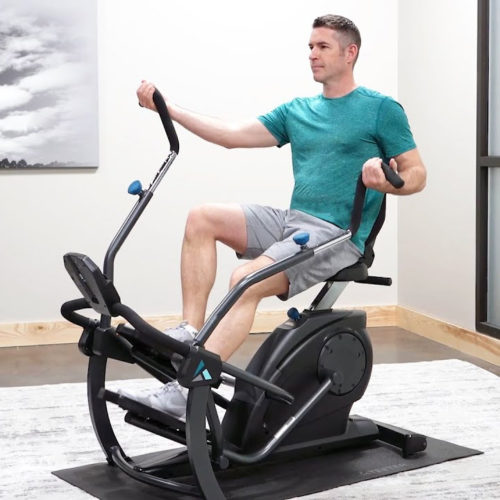When it comes to getting a comfortable, low-impact cardio workout from home, two different exercise machines immediately come to mind – the recumbent cross trainer and the recumbent bike.
Recumbent cross trainers aren’t as widely known as exercise bikes, but in certain situations, they can be superior- mostly in terms of overall low-impactness (I’m pretty sure that’s not a real word).
And even though these 2 styles of exercise machine are very similar, there are subtle differences worth knowing about before you decide on your next cardio machine.
In this guide, I’ll be comparing recumbent cross trainers and recumbent bikes, so you can see the strengths and weaknesses of each.
I’ll also provide my 2 cents regarding which machine I think is better suited for whom.
After reading, you’ll know everything you need to in order to decide which option is best suited for your home.
Off we go.
What Are Recumbent Cross Trainers?
First things first – we should probably make sure we’re all talking about the same thing here.
A recumbent cross trainer is basically the result of combining a recumbent bike with an elliptical machine.
You might see recumbent cross trainers referred to as “recumbent trainers”, “recumbent ellipticals”, or even “recumbent steppers”, but they’re all the same thing.
All of these machines have you sitting in a recumbent position like a recumbent bike, but instead of pedaling in a circular motion, you’re pushing the large pedals in a more linear pattern.
The movement pattern of the pedals will vary from machine to machine and this is something worth considering, depending on how low-impact you’re looking to go.
But all true recumbent trainers will have a more linear or oval shaped pedaling movement when compared to recumbent bikes.
Recumbent cross trainers also come with moving handles that can be used to work your arms at the same time (like an elliptical).
The most famous cross trainer brand around is Nu-Step, which provides top of the line cross trainers to rehab facilities and gyms across the country (they also have an impressive home lineup too).
Cross trainers like Nu-Step have become really popular in rehab and assisted living facilities because of how low-impact and comfortable these machines are to use.
Like recumbent bikes, you’re sitting on a large, supported seat (with armrests) and pushing the pedals in a horizontal alignment, which immediately puts less stress through your hips, knees, and ankles.
And with the Nu-Step’s purely linear pedal movement, it puts even less stress through the joints than an exercise bike – allowing most folks even with arthritis to be able to use them fairly comfortably.
Nu-Step’s are the gold standard for recumbent cross trainers, but they’re pretty expensive.
Luckily, there are plenty of more affordable cross trainers that are priced more effectively for home use to choose from these days (like Teeter’s FreeStep LT3).
When comparing recumbent cross trainers, it’s a good idea to look at all the standard stuff, like weight capacities, resistance levels, warranties, assembled weights, etc.
But if you’re really worried about finding the lowest-impact mode of exercise, I’d also consider that pedal movement pattern – going with a more linear pedal motion is lower impact than a more circular one.
Folks with really achy joints might have a hard time even a little rotation, so going with a more linear pedal movement is a smart idea for severe arthritis.
Recumbent Cross Trainers vs Recumbent Bikes
Ok, I hope we’re all on the same page now regarding cross trainers, so let’s see how these things compare to the tried and true recumbent bikes we all know and love.
As the names imply, recumbent cross trainers and recumbent bikes both have you sitting in a similar position – recumbent.
“Recumbent” is just a fancier word for laying down or reclined, referring to how these machines position you so your feet and pedals are out in front of you instead of being below you like with a traditional upright bike or indoor cycle.
This horizontal position immediately puts you in a lower impact position, as well as making them both easier to get on/off than other styles of exercise bike.
Recumbent cross trainers and bikes both also come with large, supportive seats and built-in backrests (and sometimes arm rests too) – again, adding to the comfort factor, especially for people with bad backs.
Recumbent bikes and cross trainers both come with consoles with similar features, although recumbent bikes usually come with more advanced tech (bluetooth, built-in workouts, HD screens, etc).
Assembled weights and weight limits are pretty similar between these machines too, although your higher-end cross trainers like Nu-Step will probably weigh a bit more than you’re higher-end recumbent bikes.
These machines all more or less take up the same footprint of floor space too, so space requirements are pretty identical.
No, there are really 2 big differences between these 2 types of fitness machines – the pedal motion and the inclusion of moving handle bars.
As I’ve mentioned a few times already, recumbent cross trainers utilize a more linear or oval shaped pedal motion, while recumbent bikes utilize a classic, circular pedaling motion like any other exercise bike.
The pedal motion will vary depending on the cross trainer.
Often more expensive, higher-end cross trainers will use more linear motions because again, this motion puts less stress on joints, making it safer for the elderly and people dealing with achy joints.
More affordable cross trainers tend to have pedal motions with a little more rotation involved, although still not as much as recumbent bikes.
The other big difference is the the moving handle bars – like a standard elliptical, recumbent cross trainers are designed to get your arms involved too.
Most come with adjustable length handles to accommodate folks of all heights and you can always opt to use trainers without the handles too.
Oh, another subtle difference between these machines is that you’re more likely to find a swiveling seat on a recumbent cross trainer than a recumbent bike, making them easier to get on/off for people with mobility issues.
Another reason why recumbent cross trainers are so popular with rehab settings and assisted living facilities.
Something else worth considering is cost – generally speaking, recumbent cross trainers tend to be a little more expensive than recumbent bikes.
Yes, cross trainers come in a wide range of prices too, but if you look closely, a lot of the really affordable “cross trainers” are just recumbent bikes with handles attached.
You can find really affordable recumbent bikes for a couple hundred bucks, but the most affordable legit cross trainer is likely going to cost closer to $1k.
| Recumbent Cross Trainers | Recumbent Bikes | |
|---|---|---|
| Pedal motion | Linear/oval | Circular |
| Moving handles | Yes | No |
| Comfort | Large seat, back rest, very low impact | Large seat, back rest, low impact |
| Swivel Seat | Some | Usually no |
| Console Features | Some | More |
| Cost | Usually higher | Wide range |
Which Is A Better Fit?
When trying to decide between a recumbent cross trainer and a recumbent bike, I think it really comes down to comfort level and joint issues.
Both machines are very low impact in comparison to treadmills and standing ellipticals, but recumbent cross trainers are even more low impact than recumbent bikes.
So, if joint pain is a serious issue, a recumbent cross trainer may be the better fit.
Again, it all has to do with that linear, stepping type of pedal motion.
If you’ll be transferring to your cardio machine from a wheelchair or if you have other more severe mobility issues, a recumbent cross trainer may also be a better idea because of the ability to get a swivel seat.
These can certainly make it a lot easier to get on/off the machine.
But, if you’re looking for a comfortable mode of exercise but don’t have any issues with circular motion, a recumbent bike might work better.
Recumbent bikes are still very low impact in their own right and some people prefer the faster cadences you can reach on these cycles.
Recumbent bikes also tend to be more affordable, so if cost is an issue, this could be all the difference you need.
Something else worth thinking about – with recumbent cross trainers you can use the handles to get your arms moving, which can be helpful for people with upper extremity weakness or range of motion issues.
Final Thoughts
Recumbent cross trainers and recumbent bikes are similar in a lot of ways, but there are a few key differences between these cardio machines.
Most notably found in the handles and the way the pedals move.
There are a lot more recumbent bikes to choose from than cross trainers these days, but we’re seeing more trainers gradually hit the market.
We have Nu-Step to thank for these awesome devices and they continue to be the leading brand today.
When deciding between a trainer or a recumbent bike, it all comes down to finding a machine you’ll be able to use comfortably, safely, and that won’t destroy your budget.
Recumbent cross trainers aren’t better than recumbent bikes, they’re just different.





